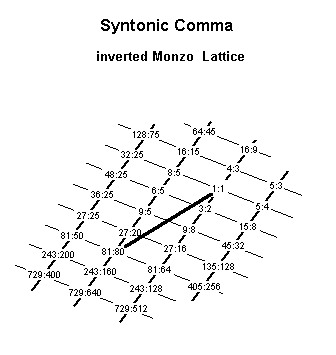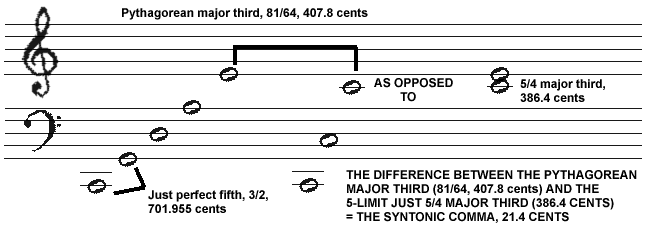Syntonic Comma
The ratio 81/80, in JustMusic prime-factor notation designated as 345-1, reducible to 1:1.0125, with an interval size of 0.22 Semitones [= ~21.5062896 (~211/2) cents].
It is the difference between the
Pythagorean or
3-Limit
"major 3rd"
of 4.08 Semitones
[= 81/64 = 34 = ~407.8200035 cents] and the 5-limit
"just" "major 3rd"
of 3.86 Semitones [= 5/4 = 51 = ~386.3137139 cents] :
-- prime-factor vector --
2 3 5 ratio ~cents
[-6 4 0] = 2-6 34 81/64 407.8200035
- [-2 0 1] = 2-2 51 5/4 386.3137139
------------
[-4 4 -1] = 2-4 34 5-1 81/80 21.5062896
Below is a 2-dimensional Monzo
lattice illustrating the [3,5] components of the
prime-factorization
of one example of the syntonic comma:

Also known as
the Comma of Didymus, who was the first theorist to specify the use of 5/4 in
music theory; frequently referred to simply as comma.
Below are some other interval measurements for the syntonic comma:
~0.215062896 (~2/9) Semitone
~1.290377376 (~1 2/7) 72edo-moria
~5.376572399 (~5 3/8) savarts
~11.00065477 (~11) grads
~13.08299284 (~13 1/12) 730edo Woolhouse-units
~17.921908 (~17 59/64) milli8ves
~18.99722248 (~18 359/360) Türk cents
~21.5062896 (~21 1/2) cents
~539.5031964 (~539 1/2) jots
~660.0392862 (~660) tuning units
~880.8976219 (~880 8/9) cawapus
~3523.590488 (~3523 3/5) midipus
[from Joe Monzo,
JustMusic:
A New Harmony]
The
syntonic comma is the most important of the musical
commas for the notation of musical
intervals.
While the Pythagorean comma
aids in the construction and analysis of tuning systems,
the Syntonic comma defines the way thirds are notated
in chords.

[from Brian McLaren]
A small interval whose ratio is 81/80 (21.5 cents [˘]).
It is the difference between the Ditone and the ratio 5/4, the Major Third of Just Intonation.
Also called the Comma of Didymos (latinized as Didymus).
[from John Chalmers, Divisions of the Tetrachord]
see also comma pump, comma
Updated:
2002.09.28 -- added vector math and table of interval measurements
2002.01.27
|
(to download a zip file of the entire Dictionary, click here) |
|
|